Snapshots of IQC
What do you do when your lab space is too small to test the distance requirements for a new long-range sensor and detector in development? Alex Maierean and Luke Neal, graduate students at the Institute for Quantum Computing (IQC) recently navigated this challenge for their latest project.
Their project is looking to advance one application of quantum sensing by incorporating techniques from quantum key distribution into light detection and ranging (LiDAR) sensors. These sensors are commonly used without quantum components for a wide variety of applications, including 3-dimensional imaging for self-driving vehicles, but have a very limited range and require bright laser beams with many photons to take a measurement.
“Typical LiDAR works by probing its environment with light and tracking the timing to calculate the distance. In our experiments, on top of tracking timing, we introduce an additional (coherent) encoding for the light inspired by QKD techniques,” says Maierean, a master’s student in the University of Waterloo’s Department of Applied Math supervised by IQC’s Dr. Thomas Jennewein and Dr. Norbert Lütkenhaus. “By doing this, we hope to increase the range, and decrease the number of photons needed to make a measurement. We’re currently working with a prototype and in the process of patenting and commercializing this device through a newly launched startup.”
One benefit of coupling lidar with coherence encoding is an extended range. To study the range of their prototype and see how larger distances would affect the functionality, Maierean and Neal needed to find a distance larger than the 10 meters available in their lab. This brought them to the longest indoor corridor at IQC, where they were able to extend the range of their experiments to 50 meters.
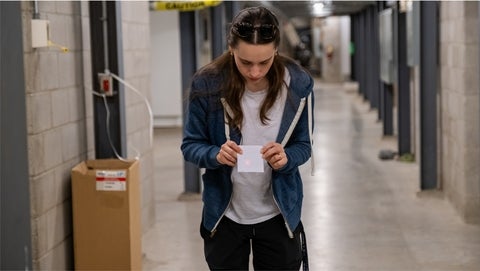
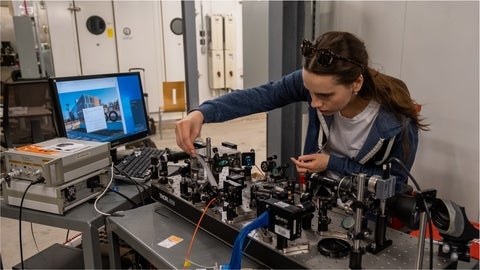


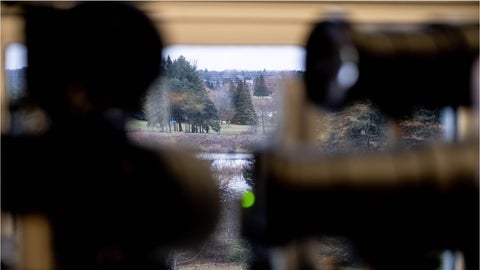
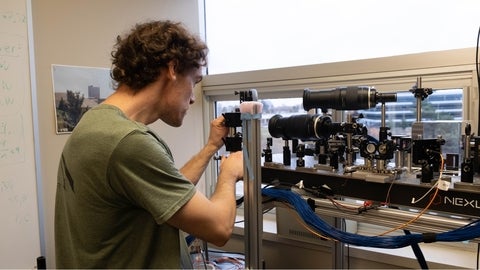
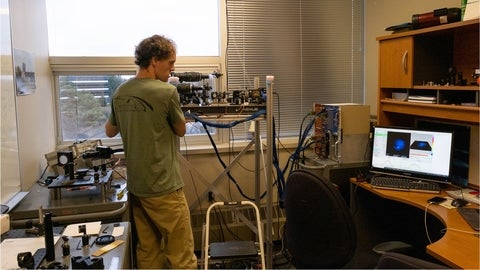
“Testing over long distances is important,” said Neal, a PhD student at IQC and the Department of Physics and Astronomy. “The type of encoding we’re using is more resistant to decoherence from the atmosphere, which can increase the range of the LiDAR.”
This experiment involved bringing their sensitive setup across QNC and up an elevator, bumping and misaligning the perfectly aligned lasers, mirrors and beam splitters.
“After transporting the setup, we anticipated a little bit of misalignment, but we were taking our measurements right up to the third and final day we had use of the space,” said Maierean. “By the end though, we experienced no difference in the quality of the data that we were able to obtain. It was very encouraging for farther distance tests.”
Their promising results have since developed into testing their LiDAR sensor out windows, pointing to targets made of reflective street-sign materials. The new experiments have now successfully received light back from targets set up in the field outside the window up to one kilometer away.
“I'm excited that our simulations were validated,” says Maierean, “and that we can look forward to the device functioning in a wider array of applications.”
Lidar quantique
Récapitulatif de l’IQC
Que faire lorsque le laboratoire est trop petit pour mettre à l’essai les exigences de distance d’un capteur et détecteur à longue portée en cours d’élaboration? Alex Maierean et Luke Neal, étudiants au cycle supérieur à l’Institut d’informatique quantique (IQC), ont récemment composé avec ce problème dans le cadre de leur dernier projet.
Ce projet avait pour but de faire avancer une application de détection quantique en intégrant des techniques de distribution quantique de clés à des capteurs de détection et de télémétrie par la lumière (lidar). Couramment utilisés sans composants quantiques pour un large éventail d’applications – comme l’imagerie 3D pour les véhicules autonomes –, ces capteurs ont toutefois une portée très limitée et nécessitent des faisceaux laser puissants riches en photons pour prendre une mesure.
« Le lidar typique calcule la distance en fonction du temps écoulé entre l’émission et la réflexion de la lumière. Lors de nos expériences, nous avons ajouté à cette méthode un encodage supplémentaire (cohérent) pour la lumière, inspiré des techniques de la DQC », explique Alex Maierean, étudiante à la maîtrise au Département de mathématiques appliquées de l’Université de Waterloo et supervisée par Thomas Jennewein et Norbert Lütkenhaus de l’IQC. « Ainsi, nous espérons augmenter la portée et réduire le nombre de photons nécessaires pour prendre une mesure. Nous travaillons présentement avec un prototype, que nous sommes en train de breveter et de commercialiser en passant par une toute nouvelle entreprise en démarrage. »
Un avantage de jumeler lidar et encodage cohérent : la portée étendue. Pour étudier la portée de leur prototype et vérifier si les grandes distances pourraient affecter le fonctionnement, Alex Maierean et Luke Neal ont dû trouver une distance dépassant les dix mètres de leur laboratoire. Ils se sont donc rendus dans le plus long corridor intérieur de l’IQC, où ils ont pu étendre la portée de leur appareil à 50 mètres.







« Il est important de faire des essais sur de longues distances, note Luke Neal, étudiant au doctorat à l’IQC et au Département de physique et d’astronomie. Le type d’encodage que nous utilisons est plus résistant à la décohérence de l’atmosphère, ce qui permet d’augmenter la portée du lidar. »
Les deux étudiants ont dû transporter leur fragile installation dans le Quantum-Nano Centre (QNC), et lui faire prendre l’ascenseur, en faisant rebondir et en brisant l’alignement parfait des lasers, des miroirs et des séparateurs de faisceau au passage.
« Après le transport de l’installation, nous nous attendions à un certain désalignement, mais nous avons pris des mesures jusqu’au troisième et dernier jour de l’utilisation de l’espace, exprime Alex Maierean. Même que vers la fin, nous ne ressentions aucune différence dans la qualité des données obtenues. C’était très encourageant pour les essais à des distances encore plus grandes. »
Leurs résultats prometteurs ont mené à des essais de capteurs lidar, qui pointent à travers des fenêtres vers du matériel de panneaux routiers réfléchissant. Les nouvelles expériences ont réussi à faire réfléchir par la fenêtre la lumière de cibles installées dans un champ à une distance allant jusqu’à un kilomètre.
« Je suis heureuse que nos simulations aient été validées et que nous puissions espérer que l’appareil fonctionne dans un plus grand éventail d’applications », avoue Alex Maierean.